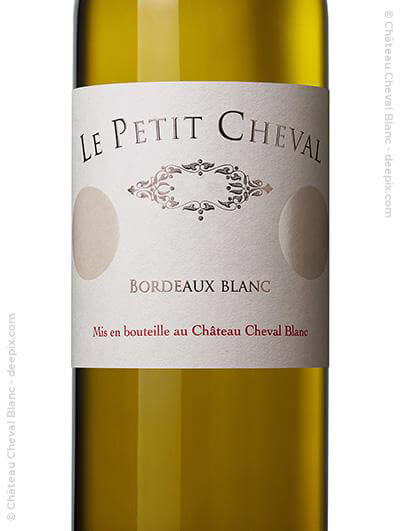
Le Petit Cheval 2022
- DeliveryFree Home delivery for orders exceeding €300
Marks and reviews
 J. Suckling
J. Suckling Vinous - A. Galloni
Vinous - A. GalloniDescription
Characteristics and tasting tips for Le Petit Cheval 2022
Tasting
Nose
The nose, elegant and fresh, offers notes of yellow fruits, citrus, beeswax, enriched on aeration by buttery and floral touches, all reflecting the indulgence of the sunny vintage.
Palate
The palate, round and supple, reveals a gentle acidity, balanced by a bitterness that prolongs the wine. A subtle oakiness enriches the delicate texture, conferring volume and complexity.
The freshness and precision of a dry white Bordeaux wine
The property
Known worldwide, Château Cheval Blanc, 1er Grand Cru Classé A, is part of the legendary properties of the wines from the right bank of the Bordeaux region. The Second Wine of the property, Petit Cheval, offers a superb introduction to the excellence of the grand wine Cheval Blanc, with refined, powerful wines, on a palate with striking and indulgent fruit. With a new cellar designed by Christian de Portzamparc and inaugurated in June 2011, Château Cheval Blanc continues to write the legend of the greatest Bordeaux wines.
The wine
Produced in the Bordeaux Dry White appellation, Le Petit Cheval is the result of an adventure and a challenge that Château Cheval Blanc set itself more than 10 years ago: to produce a very great white wine on a terroir historically renowned for its red wines. If the initial idea was to produce a wine intended for exclusively family and friendly production, very quickly, the idea of making it a very great wine became an obvious choice.
The vineyard
Embodying the essence of Cheval Blanc's identity, Le Petit Cheval blanc enjoys a plot that is entirely dedicated to it. This 6.6 hectare vineyard was formerly that of la Tour du Pin. Benefiting from its own winemaking and ageing tool, Le Petit Cheval blanc is thus assembled from a mosaic of 13 different plots combining vines planted on sandy soils and clay soils.
Vinification and ageing
After pressing, the slightly settled musts ferment in demi-muids, foudres and wooden vats. The lees stirring, initially daily, become less frequent according to the tastings of the team. The wines assembled in February continue their ageing for 18 months, before being racked for stabilisation, fining and clarification, then bottled in May.
Blend
Sauvignon Blanc (71%)
Sémillon (29%)



